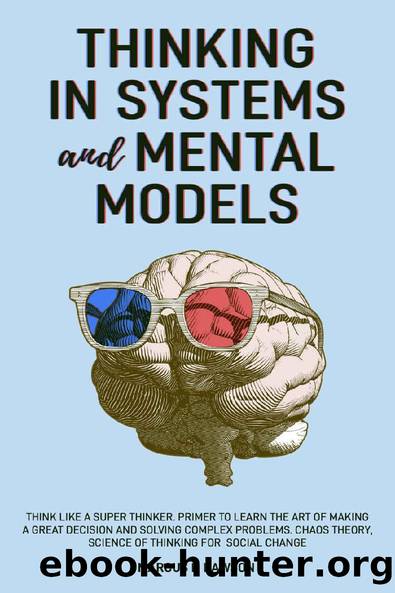Thinking in Systems and Mental Models: Think Like a Super Thinker. Primer to Learn the Art of Making a Great Decision and Solving Complex Problems. Chaos Theory, Science of Thinking for Social Change by Marcus P. Dawson

Author:Marcus P. Dawson [Dawson, Marcus P.]
Language: eng
Format: epub
Published: 2020-10-17T00:00:00+00:00
Part 2
Mental Models
Introduction
Mental models, at their most basic level, are an explanation of the thought process one has regarding the way things in the real-world work. The relationship between the various parts of what is being analyzed, along with oneâs own actions, feelings, consequences, etc., is taken into account to interpret potential consequences, outcomes, and more.
This is mostly a very detailed breakdown of a process that occurs quite organically and seemingly involuntarily. To keep track of mental models, analyze them, and change them is a very basic part of mastering your mental fortitude and eliminating the barriers that stand between you and what you want in life. When you think about what it is that keeps you from achieving the things you want in life, you will generally find that some combination of your mindset and external circumstances are what prevented success.
Knowing this, we take another step to unravel that mental process. The more factors of which we can take control of a situation, the more likely it is that weâll successfully emerge. That makes a good bit of sense, doesnât it? Thatâs the aim of this writing and the information in it.
A mental model, simply put, is a representation of the simple mechanics on something. This is a very broad statement, but mental models are inherently broad, as you can apply a model to literally anything in life. Itâs impossible for us to keep every minute detail of everything we encounter in the world, so these models act to simplify the more complex aspects of life into more digestible and organizable units.
The nature and quality of our thought processes are proportional to the mental models weâve identified and their suitability for the situation currently at hand.
The more models with which youâre familiar, the more likely you are to be equipped to accurately understand and to deal with the situation in front of you.
Most of us have a particular focus or specialization for the models we adopt, which is based on our personal and work experience. For example, someone who works in engineering might think of things in more of systematic way, while someone who deals with children for a large part of their day would think in terms of incentives or rewards. By pinpointing the type of mindset, we have and by systematically broadening our scope and arsenal of mental models, we can see things from a more panoramic perspective. By being able to do so, we eliminate the possibilities of blind spots forming in our thought process.
While nothing is guaranteed in life, there is still something to be said for understanding as much as we can about the human thought process, the patterns it follows, and how you can use that to improve your odds of success.
The term mental model dates back to 1943 when Kenneth Craik, in his writing The Nature of Explanation, indicated that children create mental models as a way of understanding the world around them. He further stipulated that humans hold small models of representations of reality that they use to make decisions, reason, and solve problems.
Download
This site does not store any files on its server. We only index and link to content provided by other sites. Please contact the content providers to delete copyright contents if any and email us, we'll remove relevant links or contents immediately.
The Art of Thinking Clearly by Rolf Dobelli(10124)
Mindhunter: Inside the FBI's Elite Serial Crime Unit by John E. Douglas & Mark Olshaker(9089)
Change Your Questions, Change Your Life by Marilee Adams(7550)
Nudge - Improving Decisions about Health, Wealth, and Happiness by Thaler Sunstein(7446)
Mastermind: How to Think Like Sherlock Holmes by Maria Konnikova(7140)
The Power of Now: A Guide to Spiritual Enlightenment by Eckhart Tolle(5520)
Men In Love by Nancy Friday(5100)
Altered Sensations by David Pantalony(4995)
Factfulness: Ten Reasons We're Wrong About the World – and Why Things Are Better Than You Think by Hans Rosling(4616)
The Confidence Code by Katty Kay(4146)
Thinking in Bets by Annie Duke(4112)
Man and His Symbols by Carl Gustav Jung(3998)
The Worm at the Core by Sheldon Solomon(3388)
Why Buddhism is True by Robert Wright(3364)
Liar's Poker by Michael Lewis(3312)
Three Women by Lisa Taddeo(3310)
The Inner Life of Animals by Peter Wohlleben(3187)
Descartes' Error by Antonio Damasio(3183)
The Power of Mindful Learning by Ellen J. Langer(3126)
